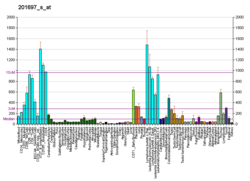Clinical significance
DNMT1 plays a critical role in Hematopoietic stem cell (HSC) maintenance. HSCs with reduced DNMT1 fail to self-renew efficiently post-transplantation. [22] It has also been shown to be critical for other stem cell types such as Intestinal stem cells (ISCs) and Mammary stem cells (MaSCs). Conditional deletion of DNMT1 results in overall intestinal hypomethylation, crypt expansion and altered differentiation timing of ISCs, and proliferation and maintenance of MaSCs. [23]
DNMT1 plays a crucial role in maintaining DNA methylation patterns, which are vital for regulating gene expression and maintaining cellular identity in cancer. [24] Dysregulation of DNMT1 can lead to abnormal methylation patterns, contributing to oncogene activation or tumor suppressor gene silencing, thereby promoting cancer progression and metastasis.
Given the role of DNMT1 in maintaining DNA methylation patterns crucial for gene regulation in cancer, the inhibition of DNMT1 by brazilin, a compound from Caesalpinia sappan, is significant. By reducing DNMT1 expression and altering methylation states through activation of p38 MAPK and elevation of p53 in MCF-7 breast cancer cells, brazilin leads to the restoration of p21 expression. [25] This mechanism highlights brazilin's potential as a therapeutic agent to correct epigenetic alterations associated with cancer progression and metastasis.
This page is based on this
Wikipedia article Text is available under the
CC BY-SA 4.0 license; additional terms may apply.
Images, videos and audio are available under their respective licenses.




